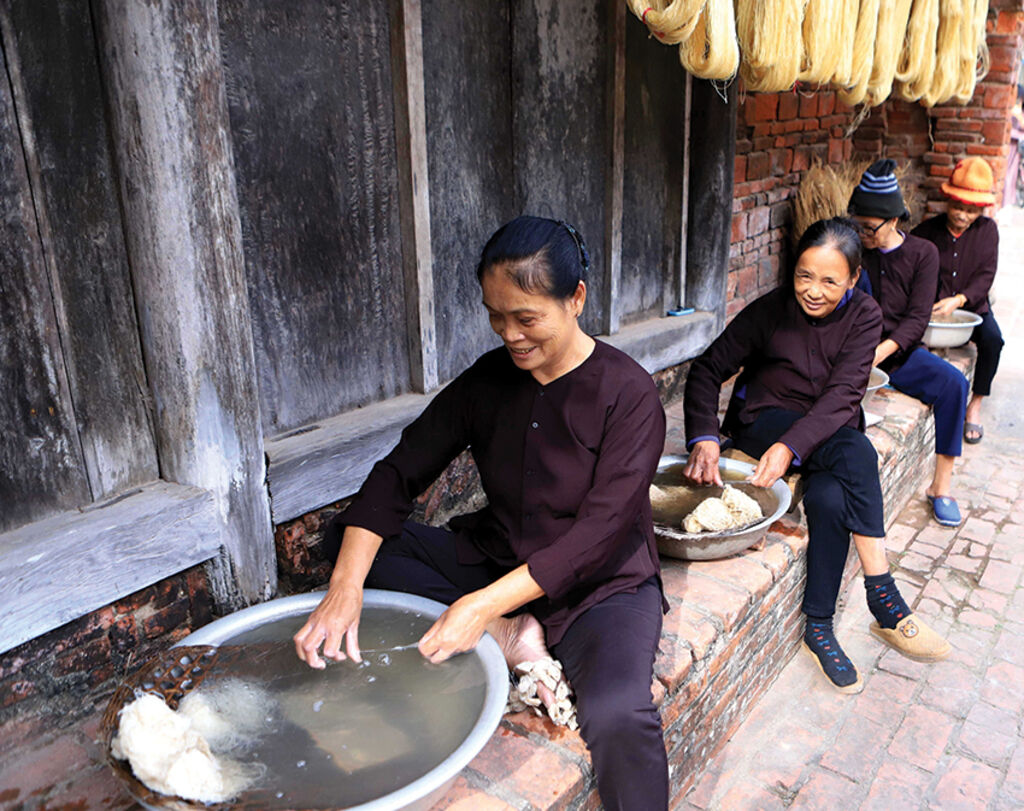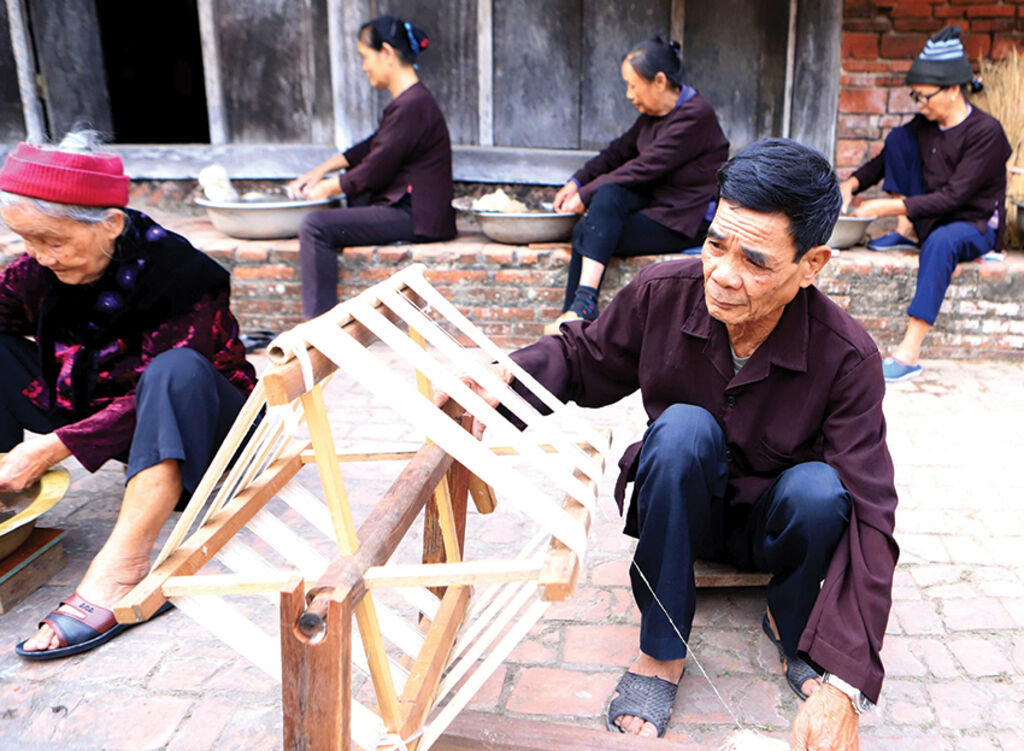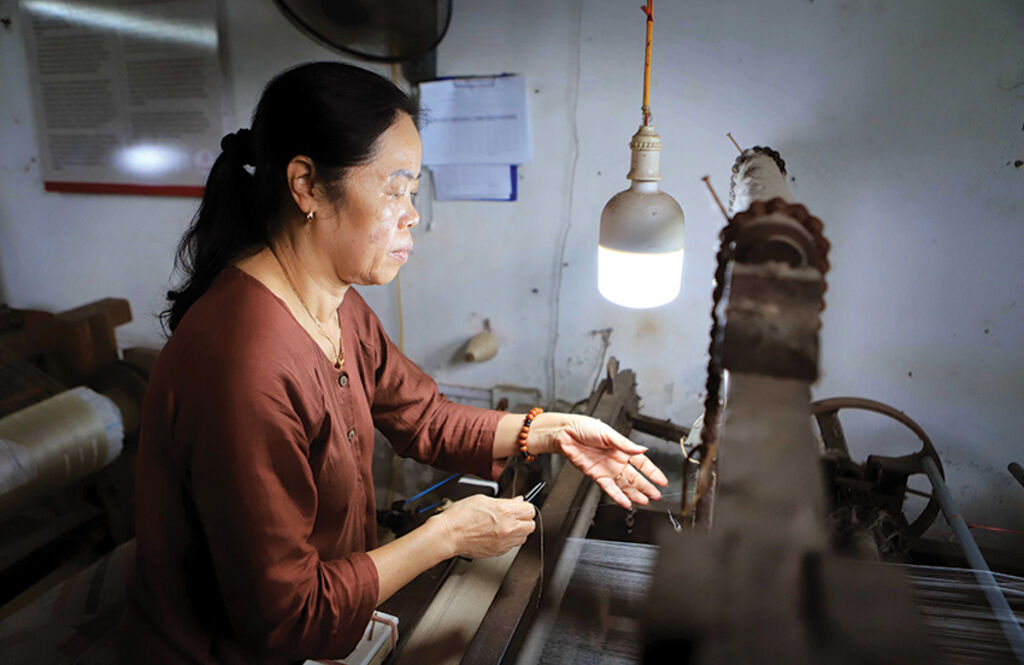 |
| Nam Cao tussah silk craft village has significant potential in development of community-based tourism__Photo: VNA |
Tussah, tussar, tusar, tasar, and more… so many names for just one type of mulberry silk fabric that has been the typical product of Cao Bat - a craft village located by the Red River bank in Nam Cao commune, Kien Xuong district, Thai Binh province.
Historical documents revealed that the silk weaving craft came into existence in Thai Binh province long time ago, before blacksmithing, casting and bamboo and rattan weaving craft. In 1584, Tu Tien and Tu An, two ladies from the mulberry and silkworm farming village of Van Xa, Bat Bat district, Son Tay region (now Son Tay town, Hanoi), who married into Cao Bat village, returned to their homeland to learn the craft and then came back and handed down the craft to their children and grandchildren.
 |
| Unravelling silk threads from cocoons dipped in water __Photo: The Duyet/VNA |
The ups and downs of the traditional craft
In the initial stage, Cao Bat villagers were just able to weave narrow-width tussah silk strips which were usually worn by women around the waist as a decorative item. Time goes by and thanks to the appearance of new techniques, villagers managed to increase the width of tussah silk fabrics up to 90cm, the width that is needed for the fabrics to be usable to make clothes.
Since then, the craft had been strongly developed. Tussah silk from Cao Bat village was not only sold at home but also exported to many countries around the world. In late 19th and early 20th century, the village’s tussah silk fabrics had been exported to France in large quantities. The craft underwent rapid development with the formation of Nam Cao Handicraft Cooperative and the 1980s could be considered the heyday of Nam Cao tussah silk as the cooperative exported more than 4,000sq.m of tussah fabrics to Eastern Europe each year. After the shrinkage of the traditional old market, Nam Cao tussah silk found its foothold in new markets such as Laos, Cambodia and Eastern Asian nations.
 |
| Spinning silk threads to make bobbins of different sizes__Photo: The Duyet/VNA |
However, the emergence of industrial woven fabrics in the country in the time between 1990 and 2010 had brought the craft village to the brink of collapse when most of craft families cast off their looms and quit their jobs. In 2012, there were only three families still practicing the traditional craft.
It was a Hanoian, Luong Thanh Hanh, who had the credit of reviving the craft of tussah silk weaving. Right after her first visit to Nam Cao commune in 2012, Hanh, who had always had a love for traditional raw silk fabrics, decided that she had to do something for the craft village. She persuaded villagers to join hands with one another to preserve and promote the endangered craft. In 2016, with the support of craftsmen in the village, Hanh established the Nam Cao Tussah Silk Cooperative. After nearly a decade, the cooperative is now home to more than 200 craftspeople and possesses a mulberry tree growing area of 300 hectares. The efforts to revive the craft were reciprocated. In November 2023, the traditional tussah silk weaving craft in Nam Cao commune was recognized as a national intangible cultural heritage.
 |
| Weaving tussah silk fabrics on a manual wooden loom__Photo: The Duyet/VNA |
Tussah silk weaving process
The production of tussah silk by traditional method must undergo some 20 steps, ranging from growing mulberries and raising silkworms to reeling, weaving and dying, which all require delicacy of artisans’ skillful touch.
The quality of silk yarns depends on sericulture. In order to have the best silk yarn, silkworms are fed with finest organic mulberry leaves five times a day. If silkworms are not properly fed, both the quantity and quality of silk fibers will be affected. Silkworms need to be raised in clean and well-aerated environment with an ideal room temperature of between 22 and 25 degrees Celsius. At the 21st or 22nd day, mature silkworms are put on racks stuffed with straw. Mature silkworms spit the silk out of an organ, called a spinneret. After some two days, the cocoons become ready to harvest. During that time, silkworm racks are exposed to mild sunlight for the cocoons to become harder with shiny golden color.
Collected cocoons are then soaked in a pot of water. After the water boils, the pot is buried in hot ash for six hours. To make cocoons harder and silk threads easier to unwind, they are soaked in cold water mixed with a special material - crushed Streblus asper Lour leaves.
Artisans dip cocoons in clean water and use their own fingers to unravel silk threads. As silk fibers are easily broken and tangled, they must be very patient and careful. If the threads are not unwound properly, they might snap when put on the spinning wheel.
Silk threads are then wound onto a spinning wheel to make bobbins of different sizes. The next step is warping which is considered the most difficult one in weaving tussah silk fabrics. Tussah silk fabrics of a width of 80cm often have 1,440 warp yarns while 30cm-wide fabrics have 540 warp yarns. It takes two or even three days for an experienced artisan to weave a 90m-wide, 50m-long tussah silk fabric roll.
The final step of producing tussah silk is dying. Nowadays, artisans in Nam Cao still use natural dyes as their ancestors did. They use gac fruit flesh for red, magenta plant leaves for purple, indigo tree for navy blue, tropical almond leaves or turmeric roots for yellow, etc. After dyed and dried, tussah silk fabrics are now ready to be made into various products, ranging from clothes to bedsheets, pillowcases, lampshades and curtains.-









